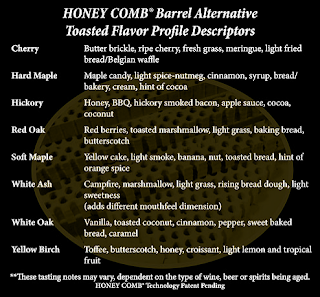This experiment was inspired by a post I read at local beer blogger site, Lewy Brewing. He bought some oak "honeycomb" inserts to use in his beers. I took a look through the Black Swam Barrels website and the below paragraph caught my attention:
I decided to buy one 5 gal honeycomb insert of each (except Hickory, not a big fan) and at $2/piece. You have to email them (heidi@blackswanbarrels.com) and then they will reply with a quote. They sent my samples within the week and then I mailed them a check.


I received 7 individually wrapped honeycomb inserts. For this experiment, I thought my Scottish 80/- would be a great base beer to test the flavors on. It has a nice malt backbone, but is not too strong to let us taste the difference in wood varieties. I made a 10 gal batch (5 in a carboy, 5 in a keg) and then transferred .5 gal from each fermenter into 7 - 1 gal jugs (the leftover was kegged and is in the fridge).
I had to cut the 5" sticks into a 1" cube so that it is the right dose for 1 gal. Then the cube was microwaved with filtered water for 3 min and allowed to cool before pitching the whole thing into the 1 gal jug. This process took a while, but I was catching up on episodes of Brewing TV.

Now, it is time to wait 6 weeks (suggested extraction time) and then the next chore of bottling 7 individual gallon jugs begins. The plan is to get a small group together to taste the beers and make some notes on each type of wood to see if we agree with what Black Swan Barrels described.


So stay tuned for a future tasting post.
I decided to buy one 5 gal honeycomb insert of each (except Hickory, not a big fan) and at $2/piece. You have to email them (heidi@blackswanbarrels.com) and then they will reply with a quote. They sent my samples within the week and then I mailed them a check.


I received 7 individually wrapped honeycomb inserts. For this experiment, I thought my Scottish 80/- would be a great base beer to test the flavors on. It has a nice malt backbone, but is not too strong to let us taste the difference in wood varieties. I made a 10 gal batch (5 in a carboy, 5 in a keg) and then transferred .5 gal from each fermenter into 7 - 1 gal jugs (the leftover was kegged and is in the fridge).
I had to cut the 5" sticks into a 1" cube so that it is the right dose for 1 gal. Then the cube was microwaved with filtered water for 3 min and allowed to cool before pitching the whole thing into the 1 gal jug. This process took a while, but I was catching up on episodes of Brewing TV.

Now, it is time to wait 6 weeks (suggested extraction time) and then the next chore of bottling 7 individual gallon jugs begins. The plan is to get a small group together to taste the beers and make some notes on each type of wood to see if we agree with what Black Swan Barrels described.


So stay tuned for a future tasting post.





Beyond the familiar characteristics of oak, the most interesting alternatives to me are the hard maple (syrup, bread!) and cherry wood (ripe cherry, Belgian waffle!). But, based on the characteristics described by Black Swan, I would wager that the White Ash could go well with your Scottish 80/-. I could see campfire and light grass lending themselves nicely to that style. I wonder what sort of "different mouthfeel dimension" is added by it's addition?
ReplyDeleteI am so excited to see the results of your experiment. I have 2 honeycombs in sour beers (1 Gallons) and one was dipped in an IPA for 24 hours. But your experiment is much more scientific. If you need anything, please let me know.
ReplyDeleteI was thinking that both of you guys would be a part of my taste panel. I have another brewing buddy or 2 that will probably join also.
ReplyDeleteSo keep your calendars available for some time in mid June. (6 week extraction + 2 week bottle condition)
Let me know if you guys are interested and when the date gets closer, we will firm up a date.
Count me in. It sounds like a great way to spend an evening.
DeleteInteresting, although I wonder how much of the more subtle flavors of these woods will be hidden by the malty base beer they are going into?
ReplyDeleteMaybe you could do a blonde or something like in the future with them as well??
The subtlies might be lost, but I really like the combo of Scottish Ales and wood aging. Last year, I did a similar Scottish 80 on French Oak for a year and it was one of my favorite beers.
DeleteI will have plenty of wood left over for a few more experiments - I think a table strength Saison or Belgian Single might be a great base beer to try these on.